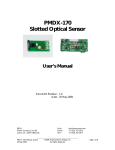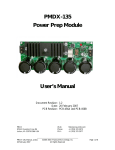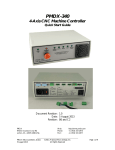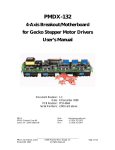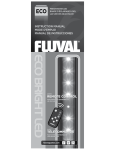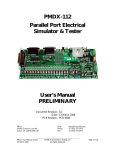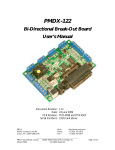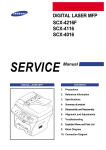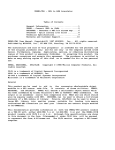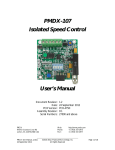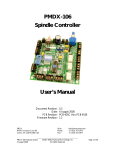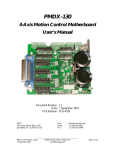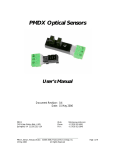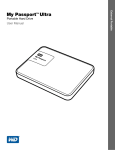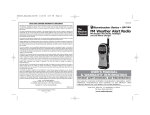Download PMDX-150 3-Amp Bipolar Micro-Stepping Motor Driver User`s Manual
Transcript
PMDX-150 3 Amp Bipolar Micro-Stepping Motor Driver User’s Manual Document Revision: Date: PCB Revision: Firmware Revision: PMDX 9704D Gunston Cove Rd Lorton, VA 22079-2366 USA PMDX-150_Manual_16.doc 18 January 2007 1.6 18 January 2007 PCB-402D 1.0 Web: Phone: FAX: http://www.pmdx.com +1 (703) 372-2975 +1 (703) 372-2977 ©2004-2007 Practical Micro Design, Inc. All Rights Reserved Page 1 of 17 PMDX-150 User’s Manual Document Revision: 1.6 PCB Revision: PCB-402D Firmware Revision: 1.0 Table of Contents 1.0 Overview.................................................................................................................................... 3 1.1 Important Safety Information ........................................................................................................................... 3 1.2 Warranty Summary............................................................................................................................................. 3 1.3 Features.................................................................................................................................................................. 4 1.4 Updates to this Manual ...................................................................................................................................... 4 2.0 Connectors ................................................................................................................................ 4 2.1 Power Supply and Control Connector (J1).................................................................................................. 4 2.1.1 Motor Power Supply ................................................................................................................................. 5 2.1.2 Opto-Isolator Ground Reference.......................................................................................................... 5 2.1.3 Step and Direction Inputs ........................................................................................................................ 5 2.1.4 Fault Output ................................................................................................................................................ 6 2.2 Stepper Motor Connector (J2)........................................................................................................................ 6 3.0 DIP Switch Settings.................................................................................................................. 7 3.1 Motor Current Selection................................................................................................................................... 7 3.2 Micro-Step Mode Select .................................................................................................................................... 8 3.3 Reduced Current Enable ................................................................................................................................... 8 3.4 Step Polarity.......................................................................................................................................................... 8 4.0 Micro-Stepping and Step Multiply Modes ............................................................................. 9 4.1 Step Multiplier Operating Constraints........................................................................................................... 9 4.2 Micro-Stepping (non-multiplied) Operating Constraints........................................................................... 9 5.0 Reduced Current Mode ......................................................................................................... 10 6.0 Fault Handling......................................................................................................................... 10 7.0 Miscellaneous .......................................................................................................................... 11 7.1 Activity and Status LED.................................................................................................................................... 11 7.2 Push Button Switch ........................................................................................................................................... 12 7.3 Idle Timer ............................................................................................................................................................ 12 7.4 Cooling Fan (optional)...................................................................................................................................... 12 8.0 Test Mode ................................................................................................................................ 12 9.0 Mechanical Specifications...................................................................................................... 14 10.0 Electrical and Environmental Specifications ...................................................................... 15 Appendix A – Warranty.................................................................................................................... 16 Appendix B – Power Supply and Motor Selection ........................................................................ 17 Appendix C – Motor Wiring............................................................................................................. 17 PMDX-150_Manual_16.doc 18 January 2007 ©2004-2007 Practical Micro Design, Inc. All Rights Reserved Page 2 of 17 PMDX-150 User’s Manual Document Revision: 1.6 1.0 PCB Revision: PCB-402D Firmware Revision: 1.0 Overview This document describes the configuration and operation of the PMDX-150 Micro-Stepping Motor Driver. The PMDX-150 provides an interface between a step pulse generator (a PC, etc.) and a single stepper motor, and includes diagnostic modes to assist in troubleshooting. This document pertains to the following versions of the PMDX-150: Circuit Board Revision: Firmware Revision: 1.1 PCB-402D (marked on the bottom of the board) 1.0 (marked on a label on the top side of the board) Important Safety Information The PMDX-150 is intended for integration by the purchaser into industrial control systems. It is solely the purchaser's responsibility to assure that the system is configured in a manner consistent with applicable safety requirements. Practical Micro Design, Inc. does not control how this board is integrated into the purchaser's system and cannot be responsible for guaranteeing the safety of your system. The PMDX-150 is not guaranteed to be fail-safe. The system into which the PMDX-150 is installed should provide fail-safe protection and emergency stop capability. Automated machine tools, into which the PMDX-150 may be integrated, can cause injury. Precautions should be taken to assure that operators are trained in their proper operation and safety procedures, and that they are protected from moving parts that may be under remote control and may move unexpectedly. This product may not be used in life support or other critical safety applications. 1.2 Warranty Summary The PMDX-150 is warranted against failure due to defective parts or workmanship for 90 days from the date of sale. Refer to Appendix A for complete warranty details. If you have an item requiring service, please see the support page on the PMDX web site (http://www.pmdx.com) for return instructions. The purchaser must pay shipping to return the unit to PMDX. We will ship the repaired unit back to you via ground transportation at our expense. Repairs are normally completed within 10 business days. See Appendix A for our complete warranty details. PMDX-150_Manual_16.doc 18 January 2007 ©2004-2007 Practical Micro Design, Inc. All Rights Reserved Page 3 of 17 PMDX-150 User’s Manual PCB Revision: PCB-402D Firmware Revision: 1.0 Document Revision: 1.6 1.3 Features The PMDX-150 Micro-Stepping Motor Driver is based on the Allegro A3977 micro-stepping driver chip along with a microprocessor and additional circuits to enhance performance. The use of heat sinks bonded directly to the A3977’s lead frame allows operation with up to 3.0 Amps of motor current. The PMDX-150 has the following features: Control Interface: Opto-isolated step and direction inputs Does not require a separate opto-isolator power supply 3.3V compatibility for laptop computers Opto-isolated “fault” output to signal error conditions from the PMDX-150 Latches the “Dir” (direction) input on selected edge of the “Step” input Input step rate up to 100 KHz Motor Interface: Motor connector positioned so that it can project through a panel to allow installation in a box without internal motor wiring Up to 3.0 Amp motor drive current with bipolar chopper current limiting Optional “reduced current” mode after 30 seconds of “idle” Clamping circuits to prevent damage from motor disconnect voltage spikes or back-EMF 1.4 Power Supply Input: Motor power supply input handles up to +35VDC input Protection from transient voltage spikes No separate logic or opto-coupler power supply required Self-resetting “poly switch” fuse for over current protection Protection against reversed power supply wiring Special Features: Pluggable wire clamp screw terminal strips for all connections to motor and controller Over-temperature shut-down and fault indication Micro-stepping modes – full, half, quarter and eighth step Step multiplier can output 4 steps for every one step input Test mode supports debug and jogging without a controller connection LED flashes with step input and to indicate idle, “reduced current” and fault conditions DIP switches for all settings – no jumpers or trim pots to adjust Updates to this Manual Check the PMDX web site for revisions or updates to this manual (http://www.pmdx.com). The latest revision of this manual is available on the PMDX-150 page (follow the links from the main page). 2.0 Connectors The PMDX-150 contains the following connectors. Refer to the following sections for details on the pinouts for each connector. Connector J1 J2 Description Power supply and control interface Stepper motor connections Table 1 - Summary of PMDX-150 Connectors 2.1 Power Supply and Control Connector (J1) Connector J1 contains the motor power supply connection along with the “step” and “direction” inputs, common opto-isolator “ground” and the “fault” output. Pin “1” is the pin closest to the reference PMDX-150_Manual_16.doc 18 January 2007 ©2004-2007 Practical Micro Design, Inc. All Rights Reserved Page 4 of 17 PMDX-150 User’s Manual Document Revision: 1.6 PCB Revision: PCB-402D Firmware Revision: 1.0 designator (i.e. J1 pin 1 is the pin closest to the “J1” text on the top side of the circuit board). Also, each pin is labeled on the bottom of the circuit board. Pin Number 1 2 3 4 5 6 Label Vneg Vpos Gnd Step Dir Fault Description Negative motor power supply input Positive motor power supply input Opto-isolator common reference Step input (opto-isolated) Direction input (opto-isolated) Fault output (opto-isolated) Table 2 – Power Supply and Control Connector Pin-Out (J1) 2.1.1 Motor Power Supply Connect the motor power supply to the two motor power supply terminals. This must be a DC power supply with a voltage not to exceed the maximum voltage specified in section 10.0, Electrical and Environmental Specifications. The actual power supply voltage must be chosen to match the stepper motor and performance requirements of your application. The maximum power supply current depends on the stepper motor and the PMDX-150 “motor current” DIP switch setting (see section 3.1, Motor Current Selection). 2.1.2 Opto-Isolator Ground Reference This pin provides the common “ground” reference for the opto-isolator inputs and output. This pin is normally connected to the “ground” pin of the device that generates the step and direction signals (i.e. the PC’s parallel port, a PMDX-120, etc.). This pin may also be connected to the negative motor supply (“Vneg”), but doing so will remove any isolation between the motor power supply and the step pulse generator. 2.1.3 Step and Direction Inputs The “step” and “direction” inputs are optically isolated inputs to the PMDX-150. The PMDX-150 acts on the “step” input on either the rising or falling edge, depending on the setting of the “SPOL” DIP switch (see Figure 1 below and section 3.4). The “direction” signal is latched inside the PMDX-150 on the “active” edge of the “step” pulse (selected by the SPOL DIP switch). This reduces the setup and hold requirements on the pulse generator system. See Figure 1 below for a depiction of the required step and direction timings and relationships. See section 10.0, Electrical and Environmental Specifications, for the “DIR” setup and hold values and the “Step” pulse and recovery times. PMDX-150_Manual_16.doc 18 January 2007 ©2004-2007 Practical Micro Design, Inc. All Rights Reserved Page 5 of 17 PMDX-150 User’s Manual PCB Revision: PCB-402D Firmware Revision: 1.0 Document Revision: 1.6 Min "Step" pulse width Step (SPOL switch up) Min "Step" pulse recovery Dir "Dir" hold time "Dir" setup time Min "Step" pulse width Step (SPOL switch down) Min "Step" pulse recovery Dir "Dir" hold time "Dir" setup time Figure 1 – Step and Direction Timing Diagrams 2.1.4 Fault Output The “Fault” output is an open-collector output, which is optically isolated from the PMDX-150’s motor power, and shares the common “ground” connection with the “Step” and “Dir” inputs. The fault output is “active low”, meaning that a fault condition exists with the “Fault” output is connected to the “ground” pin. See section 6.0, Fault Handling, for more information on the PMDX-150’s fault detection capabilities. 2.2 Stepper Motor Connector (J2) Connector J2 contains the stepper motor connections. The PMDX-150 supports stepper motor configurations with two motor phase windings and two connections per motor phase. Pin “1” is the pin closest to the reference designator (i.e. J2 pin 1 is the pin closest to the “J2” text on the circuit board).In addition, pin 1 has a square pad on the bottom of the circuit board. This connector can also be used to mount the PMDX-150 on a panel. See section 9.0, Mechanical Specifications, for the panel cut-out dimensions. Note that the motor rotation direction can be reversed by one of two methods: by swapping the two motor leads of one phase (either phase), or by swapping the two phases. See the appendices for more information about motor wiring. PMDX-150_Manual_16.doc 18 January 2007 ©2004-2007 Practical Micro Design, Inc. All Rights Reserved Page 6 of 17 PMDX-150 User’s Manual PCB Revision: PCB-402D Firmware Revision: 1.0 Document Revision: 1.6 Pin Number 1 2 3 4 Label Phase 1A Phase 1B Phase 2A Phase 2B Description one end of the “Phase 1” motor coil other end of the “Phase 1” motor coil one end of the “Phase 2” motor coil other end of the “Phase 2” motor coil Table 3 –Stepper Motor Connector Pin-Out (J2) WARNING: Short circuits or cross connects between motor windings will damage the PMDX-150. Be cautious when using motors that have been wired for connection to a unipolar driver because the center taps of the motor’s windings may be connected together. Five-wire unipolar setups employ this configuration. 3.0 DIP Switch Settings The PMDX-150 contains 8 DIP switches that determine various aspects of its behavior. The DIP switches are numbered “1” through “8”. These numbers also appear on the DIP switch. The functional labels shown in the table below also appear on the circuit board’s silkscreen, next to the DIP switch. In the descriptions that follow, the switch lever positions are described as “open” or “closed”. The “open” position (also called “up”) is with the switch positioned away from the circuit board (also marked “open” on the DIP switch). The “closed” position (also called “down”) is with the switch lever positioned towards the circuit board. DIP Switch Label Function 1 SEL0 2 SEL1 Motor current selection 3 SEL2 (see section 3.1) 4 SEL3 5 MS0 Micro-Step Mode Select 6 MS1 (see section 3.2) 7 RCEN Reduced current enable (see section 3.3) 8 SPOL Step polarity (see section 3.4) New Setting Activated On: Power-on or push-button press Power-on or push-button press Power-on only Immediately Table 4 - DIP Switch Summary As indicated in the table above, most of the switches are read either at power-on or when the pushbutton switch is pressed. This means that in order for the new settings to take effect, you must either power the board off and back on, or press the push-button switch (possibly entering “test” mode). The exceptions are the “RCEN” switch, which is only read at power-on, and the “SPOL” switch, which takes effect immediately. 3.1 Motor Current Selection DIP switch levers 1 through 4 select the motor current. The table below shows the motor currents supported by the PMDX-150. Note that the current settings marked with “*” may require forced air cooling to prevent thermal shutdown. Other current settings may also require forced air cooling at elevated ambient temperatures – this depends on the installation environment and motor. Section 7.4 describes how to mount a fan directly on the PMDX-150, though any forced airflow will work. If thermal shutdown occurs there is no harm to the PMDX-150. However, the unit must be reset in order to resume operation. See section 6.0, Fault Handling, for more information. PMDX-150_Manual_16.doc 18 January 2007 ©2004-2007 Practical Micro Design, Inc. All Rights Reserved Page 7 of 17 PMDX-150 User’s Manual PCB Revision: PCB-402D Firmware Revision: 1.0 Document Revision: 1.6 DIP Switch (open=up, closed=down) 4 3 2 1 Closed Closed Closed Closed Closed Closed Closed Open Closed Closed Open Closed Closed Closed Open Open Closed Open Closed Closed Closed Open Closed Open Closed Open Open Closed Closed Open Open Open Motor Current 0.75 Amps ±5% 0.96 Amps ±5% 1.15 Amps ±5% 1.30 Amps ±5% 1.44 Amps ±5% 1.58 Amps ±5% 1.72 Amps ±5% 1.86 Amps ±5% DIP Switch 4 Open Open Open Open Open Open Open Open 3 Closed Closed Closed Closed Open Open Open Open 2 Closed Closed Open Open Closed Closed Open Open 1 Closed Open Closed Open Closed Open Closed Open Motor Current 2.00 Amps ±5% 2.15 Amps ±5% 2.30 Amps ±5% 2.44 Amps ±5% 2.58 Amps* ±5% 2.72 Amps* ±5% 2.86 Amps* ±5% 3.00 Amps* ±5% Table 5 – Motor Current Select DIP Switch Settings 3.2 Micro-Step Mode Select DIP switch levers 5 and 6 select the micro-step (and step multiply) mode as described in the following table. Refer to section 4.0, Micro-Stepping and Step Multiply Modes, for information on the step pulse multiplier and the various micro-stepping modes. DIP Switch Selected Step 6 5 Mode Closed Closed Full Step Closed Open Half Step Open Closed Quarter Step Open Open Eighth Step Driver Response to Step Input Four (4) quarter-steps for each step input Four (4) eighth-steps for each step input One (1) quarter-step for each step input One (1) eighth-step for each step input Table 6 – Micro-Step Mode Select DIP Switch Settings 3.3 Reduced Current Enable DIP switch lever 7 is the “reduced current enable” (RCEN) switch. It determines whether the PMDX-150 reduces current to the motor after a period without movement. If the switch lever is “Closed” (or “down”), then the PMDX-150’s “Reduced Current” mode is disabled. If the switch lever is “Open” (or “up”), the “Reduced Current” mode is enabled. See section 5.0, Reduced Current Mode, for information on reduced current mode. WARNING: The “RCEN” switch only takes effect after powering on the board. If you change the setting of this switch you must power the board off and back on. Pressing the push-button switch will not “re-read” this setting (see section 7.2, Push Button Switch). 3.4 Step Polarity DIP switch lever 8 is the step polarity (SPOL) switch. It determines which edge of the incoming step pulse the PMDX-150 acts on. If the switch is “Closed” (or “down”), then the PMDX-150 acts on the falling edge of the incoming step pulses. If the switch is “Open” (or “up”), the PMDX-150 acts on the rising edge. WARNING: The “SPOL” switch takes effect immediately. All other DIP switches take effect only after power-on or after pressing the push-button switch (see section 7.2, Push Button Switch). PMDX-150_Manual_16.doc 18 January 2007 ©2004-2007 Practical Micro Design, Inc. All Rights Reserved Page 8 of 17 PMDX-150 User’s Manual Document Revision: 1.6 4.0 PCB Revision: PCB-402D Firmware Revision: 1.0 Micro-Stepping and Step Multiply Modes The PMDX-150 always drives the stepper motor in a micro-stepping mode – either quarter-step or eighth-step. When “full step” mode is selected via the DIP switches, the motor is actually driven in quarter step mode and the PMDX-150’s step multiplier is enabled. The PMDX-150 then outputs four step pulses for every one incoming step pulse. When “half-step” mode is selected, the motor is driven in eighth-step mode with the step multiplier enabled (generating four step pulses for every one incoming step pulse). This allows the PMDX-150 to emulate these two stepping modes while providing a smoother transition between incoming steps. When “quarter step” or “eighth step” modes are selected the PMDX-150 disables the step multiplier. The motor is driven directly in the corresponding micro-step mode. The step multiplier operates like a phase-locked loop (PLL). It predicts the interval between the mostrecent step input and the next step input. It then outputs four equally spaced step pulses during that time interval. If the incoming step rate is below a certain rate (approximately 250 steps/second), the step multiplier ceases to predict the step interval and simply outputs the four step pulses at an approximate 250 step/second rate. 4.1 Step Multiplier Operating Constraints It takes time for the step multiplier PLL to adjust to the incoming step frequency. Therefore, there are limits on the incoming step rate and how fast it can change, as shown in the following table. NOTE: These step rate limits refer to the PMDX-150’s ability to follow the step input. In actual practice, the motor’s performance will usually limit the step rates to much lower values. Parameter Operational Limit Jump-Start rate (initial step rate when starting from a dead stop) 250 steps/second maximum, but also may be limited by the motor Maximum step rate 25 KHz input step rate, multiplied to 100 KHz micro-steps to the motor Maximum step slew rate 20% change in step period between subsequent step pulses for step rates over the “jump-start” rate (250 steps/second), below that there is no limit to the slew rate (except as limited by the motor) Table 7 – Step Multiplier Operating Constraints 4.2 Micro-Stepping (non-multiplied) Operating Constraints When the PMDX-150 is operating with the step multiplier disabled (quarter-step or eighth-step modes), each step pulse in generates a single step pulse to the motor. In these cases, there are fewer constraints on the input step signal, as follows: NOTE: These step rate limits refer to the PMDX-150’s ability to follow the step input. In actual practice, the motor’s performance will usually limit the step rates to much lower values. PMDX-150_Manual_16.doc 18 January 2007 ©2004-2007 Practical Micro Design, Inc. All Rights Reserved Page 9 of 17 PMDX-150 User’s Manual Document Revision: 1.6 Parameter Operational Limit Jump-Start rate (initial step rate when starting from a dead stop) 40 KHz Maximum step rate 100 KHz Maximum step slew rate No limit PCB Revision: PCB-402D Firmware Revision: 1.0 Table 8 – Micro-Stepping (non-multiplied) Operating Constraints 5.0 Reduced Current Mode When the DIP switches are set to enable reduced current mode (see section 3.3), the PMDX-150 will detect periods of no motion (no incoming step pulses). When a motor has not moved for 30 seconds, the PMDX-150 will reduce the motor drive current to approximately half of the current specified by the DIP switches (see section 3.1). When an incoming step pulse is detected, the motor current is returned to its full value and then the motor is advanced. While the PMDX-150 is in “reduced current” mode, the LED will flash in a repeating pattern of two long flashes (one second each) followed by 3 seconds off (see also section 7.1, Activity and Status LED). 6.0 Fault Handling The PMDX-150 is self-monitoring and can detect and report several different fault conditions. When a fault is detected, the PMDX-150 enters “fault” mode and does the following: • drives the “Fault” output low • disables the motor drivers • flashes a pattern on the LED that indicates the reason for the fault Once the PMDX-150 enters “fault” mode, it remains in “fault” mode until either power is removed or the push-button is pressed. Even if the fault condition “goes away”, the PMDX-150 remains in “fault” mode until one of the two above events. This allows you to see the cause of a transient fault and assures that the system does not continue with corrupt motor positions. If the push-button is pressed and the fault condition remains (or another fault is detected), the system will re-enter “fault” mode. See section 7.2 for more information on the push-button switch. When a fault has been detected, the activity LED repeats the following pattern: • three short flashes • a short pause • some number of short flashes (indicates fault condition, see Table 9 below) • a longer pause This pattern repeats until the user presses the push button switch or power is removed from the PMDX-150. The second group of flashes indicates the reason for the fault condition as described below. PMDX-150_Manual_16.doc 18 January 2007 ©2004-2007 Practical Micro Design, Inc. All Rights Reserved Page 10 of 17 PMDX-150 User’s Manual Document Revision: 1.6 Number of flashes in second group PCB Revision: PCB-402D Firmware Revision: 1.0 Fault condition 1 Over temperature, under-voltage shutdown, or charge pump failure 2 Step pulse timing violation (see note below) 3 Reserved 4 Allegro A3977 interface failure (hardware problem) 5 to 10 Self-test or firmware error Table 9 – Fault Mode LED Indications NOTE: In addition to controller-generated step pulse timing violations, the “step pulse timing” error can also occur when strong interference signals generate false step inputs. This can occur if you run the step signal wires near the motor’s power leads, or when there is a loose connection. 7.0 Miscellaneous 7.1 Activity and Status LED The Activity LED (DS1) indicates various states in the PMDX-150 as shown in the following table: LED Pattern Off (for more than 5 seconds) Very short flashes (or flicker) One slow flash then 2 short flashes One slow flash (one second on, three seconds off) Two slow flashes (one second on, one second off, one second on, three seconds off) Three short flashes followed by a number of short flashes (repeats this pattern) On solid Description No power to the PMDX-150, or PMDX-150 board failure Incoming step pulses detected. Note that for “slow” pulse rates (less than 15 steps/second) you can discern a flash for each step pulse. For faster step rates you will see only a very fast flicker. Power on sequence complete and self-test passed Idle mode (see section 7.3, Idle Timer) Reduced current mode (see section 5.0, Reduced Current Mode) Fault mode. The second set of flashes indicates the fault that was detected. See section 6.0, Fault Handling, for more information. Push button switch pressed (see section 7.2, Push Button Switch, and section 8.0, Test Mode) Table 10 – Activity LED Flash Patterns PMDX-150_Manual_16.doc 18 January 2007 ©2004-2007 Practical Micro Design, Inc. All Rights Reserved Page 11 of 17 PMDX-150 User’s Manual Document Revision: 1.6 7.2 PCB Revision: PCB-402D Firmware Revision: 1.0 Push Button Switch Pressing the push button switch provides several functions: • When a fault condition exists, pressing the switch attempts to clear the fault and re-start the motor, see section 6.0. • Re-reads the DIP switches and implements the new settings (regardless of whether or not a fault condition exists). There are two exceptions to this: (a) The “SPOL” switch always takes effect immediately (see section 3.0, DIP Switch Settings) (b) The “RCEN” switch, which only takes effect after power-on (see section 3.0, DIP Switch Settings) • When no fault condition exists, pressing (and holding) the switch will enter “Test” mode (see section 8.0) Note that whenever the push-button switch is pressed, the LED turns on solid. 7.3 Idle Timer The PMDX-150 contains a “idle” timer. This timer detects when two seconds have elapsed since either the last incoming step pulse, or the last test mode step pulses. If two seconds elapse, the LED flashes an “idle” pattern of one slow flash (one second on, three seconds off, see section 7.1, Activity and Status LED). This gives a visual indication that the PMDX-150 has power and is active. Note that “reduced current” mode will override the “idle” LED pattern with its own flash pattern when the “reduced current” timer expires and “reduced current” mode is enabled (see section 5.0, Reduced Current Mode). 7.4 Cooling Fan (optional) Depending on the ambient temperature, motor current setting and motor that is connected to the PMDX-150, you may need to supply force-air cooling to the PMDX-150 board to prevent thermal shutdown. The forced-air cooling may be provided by an external fan moving air over the board (as is the case in the PMDX Motion Management System units), or by a fan mounted directly on the PMDX-150 board as described below. The PMDX-150 has mounting holes in two of its heat sinks for use in mounting a 45mm square fan directly to the board. The fan will be secured at only two of its corners and will be rotated 45 degrees with respect to the board. After mounting the fan, make sure that the impeller is free to rotate. Cooling is effective either with air blowing onto or away from the board. Power for the fan is not supplied by the PMDX-150 board – you must provide the fan power separately. One example of a fan that is suitable for use with the PMDX-150 is DigiKey part number 259-1196. 8.0 Test Mode The PMDX-150 provides a method for stand-alone motor testing. This test mode generates internal step and direction signals without a controller connected, using the momentary-contact push-button switch (SW2). The test mode will also operate when the PMDX-150 connected to a controller. If a controller is connected to the PMDX-150 while in test mode, the PMDX-150 will ignore the incoming step and direction signals for as long as test mode is active. While in test mode, all motor movements are made in “full step” equivalent increments. For example, in “full step” mode, a “full step” equivalent is four steps because the PMDX-150 actually drives the motor in quarter-step mode (see Table 6 on page 8 for a list of micro-step modes). Pressing and holding the push-button (when no fault is indicated) turns the LED on solid and causes the PMDX-150 to move the motor using the following profile: PMDX-150_Manual_16.doc 18 January 2007 ©2004-2007 Practical Micro Design, Inc. All Rights Reserved Page 12 of 17 PMDX-150 User’s Manual Document Revision: 1.6 PCB Revision: PCB-402D Firmware Revision: 1.0 (1) Brief pause (2) 5 full steps at a rate of 2 steps per second (3) Ramp up to 400 “full steps” per second and maintain that rate until the push button is released (note that the ramp-up, plateau and ramp-down are done using eighth-step mode, but the step rate is in “full step equivalent” steps per second) (4) Ramp down from 400 “full steps” per second to 25 “full steps” per second then stop (5) Toggle the “test mode” direction so that the next push-button press will move the motor in the opposite direction (except as described below). If the push-button is released during step (1) of the test profile, the motor halts at the next “full step” boundary. If the push-button is released during step (2) of the test profile, it immediately ramps down from the current step frequency and then stops (i.e. it does not wait until the ramp has reached it maximum frequency before ramping down and stopping). Note that if the push-button is pressed while a fault is indicated, the push-button serves to attempt to clear the fault, it does not enter test mode. When a fault is indicated, it takes two button presses to enter test mode – one to clear the fault and the second to enter test mode. Each time test mode is entered, the motor direction is reversed from the previous test mode. It is possible to “tap” the push-button to force a direction reversal without holding the switch long enough to generate a step pulse. In this manner, you can achieve successive runs of slow steps in the same direction. While not in test mode (i.e. push button not pressed), if 30 seconds elapse with no incoming step pulses, the test mode starting direction will be reset to its default power-on value. The actual motor direction depends on how the motor is connected to the PMDX-150. WARNING: If you press the push-button for test mode and nothing happens, a fault may have occurred while starting test mode. Release the push-button and look at the LED. If there was a fault, the LED will flash to indicate the fault as shown in sections 6.0 and 7.1. If the LED does not indicate a fault condition, then double-check the motor wiring and the motor power supply. PMDX-150_Manual_16.doc 18 January 2007 ©2004-2007 Practical Micro Design, Inc. All Rights Reserved Page 13 of 17 PMDX-150 User’s Manual PCB Revision: PCB-402D Firmware Revision: 1.0 Document Revision: 1.6 9.0 Mechanical Specifications 3.500" 2.900" 2.600" 0.150" 3.200" 4 each 0.150" dia holes (for #6 screw) 0.150" Figure 2 - PMDX-150 Dimensions and Mounting Holes WARNING: The PMDX-150 should be protected from liquids, dirt, or chips (especially metal chips which can cause shorts) coming in contact with the board. PMDX-150_Manual_16.doc 18 January 2007 ©2004-2007 Practical Micro Design, Inc. All Rights Reserved Page 14 of 17 PMDX-150 User’s Manual PCB Revision: PCB-402D Firmware Revision: 1.0 Document Revision: 1.6 10.0 Electrical and Environmental Specifications Motor Power: +12V DC to +35V DC, 2.0 Amps maximum (note that the chopper motor driver allows up to 3 amp motor currents using power supplies with less than 3 amp capacities) Motor Current Chopping Frequency: Step & Direction Inputs: 20 KHz (nominal) Optically isolated input signals: Max. input “high”: 12.0V at 11 mA max (referenced to the “Gnd” terminal) Min. input “high”: 3.0V at 1.6 mA (referenced to the “Gnd” terminal) Max. input “low”: 0.4V (referenced to the “Gnd” terminal) “Step” pulse width: 1.0 µs (minimum) “Step” pulse recovery: 2.0 µs (minimum) “Step” frequency: Depends on micro-stepping mode, see section 4.0 “Dir” setup time: “Dir hold time: Fault Output: 1.0 µs minimum (see section 2.1.3) 1.0 µs minimum (see section 2.1.3) Open-collector optically isolated output signal: Max “sink” current: 100 mA (referenced to the “Gnd” terminal) Max pull-up voltage: 24VDC (referenced to the “Gnd” terminal) NOTE: The open-collector output requires a pull-up resistor in the receiving equipment Environmental: Temperature: Relative Humidity: 0° to +55° C 20% to 80% relative humidity, non-condensing NOTE: Forced-air cooling may be required at elevated temperatures or with current settings above 2.5 amps. See section 3.1, Motor Current Selection, for more information. PMDX-150_Manual_16.doc 18 January 2007 ©2004-2007 Practical Micro Design, Inc. All Rights Reserved Page 15 of 17 PMDX-150 User’s Manual PCB Revision: PCB-402D Firmware Revision: 1.0 Document Revision: 1.6 Appendix A – Warranty Statement Practical Micro Design, Inc. (PMD) warrants that this hardware product is in good working condition, according to its specifications at the time of shipment, for a period of 90 days from the date it was shipped from PMD. Should the product, in PMD's opinion, malfunction within the warranty period, PMD will repair or replace the product without charge. Any replaced parts become the property of PMD. This warranty does not apply to the software component of a product or to a product which has been damaged due to accident, misuse, abuse, improper installation, usage not in accordance with product specifications and instructions, natural or personal disaster or unauthorized alterations, repairs or modifications. Limitations All warranties for this product, expressed or implied, are limited to 90 days from the date of purchase and no warranties, expressed or implied, will apply after that period. All warranties for this product, expressed or implied, shall extend only to the original purchaser. The liability of Practical Micro Design, Inc. in respect of any defective product will be limited to the repair or replacement of such product. Practical Micro Design, Inc. may use new or equivalent to new replacement parts. Practical Micro Design, Inc. makes no other representations or warranties as to fitness for purpose, merchantability or otherwise in respect of the product. No other representations, warranties or conditions, shall be implied by statute or otherwise. In no event shall Practical Micro Design, Inc. be responsible or liable for any damages arising (a) from the use of the product; (b) from the loss of use of the product; (c) from the loss of revenue or profit resulting from the use of the product; or (d) as a result of any event, circumstance, action or abuse beyond the control of Practical Micro Design, Inc. whether such damages be direct, indirect, consequential, special or otherwise and whether such damages are incurred by the person to whom this warranty extends or a third party. PMDX-150_Manual_16.doc 18 January 2007 ©2004-2007 Practical Micro Design, Inc. All Rights Reserved Page 16 of 17 PMDX-150 User’s Manual Document Revision: 1.6 PCB Revision: PCB-402D Firmware Revision: 1.0 Appendix B – Power Supply and Motor Selection To be determined. Appendix C – Motor Wiring To be determined. PMDX-150_Manual_16.doc 18 January 2007 ©2004-2007 Practical Micro Design, Inc. All Rights Reserved Page 17 of 17

















